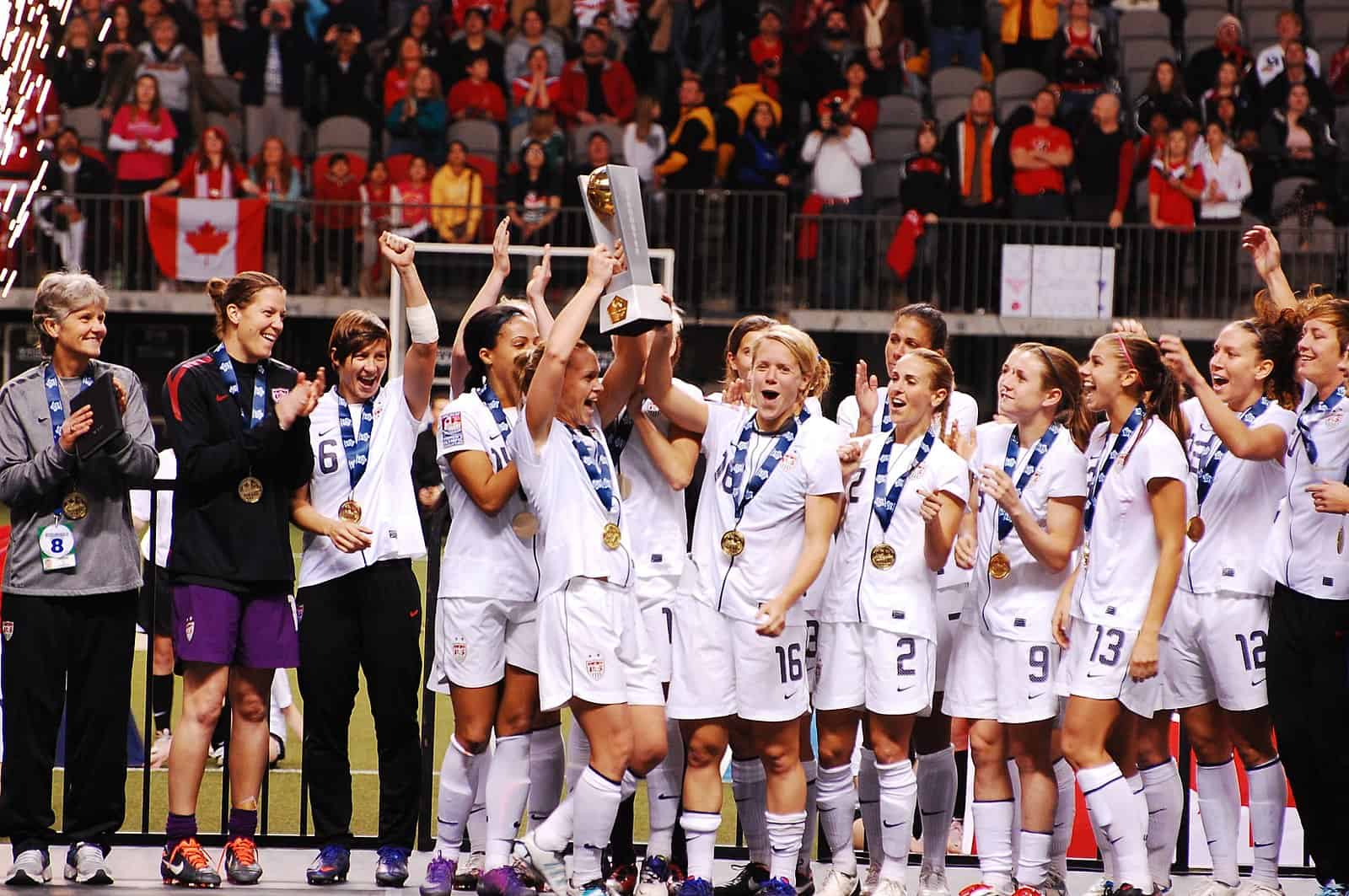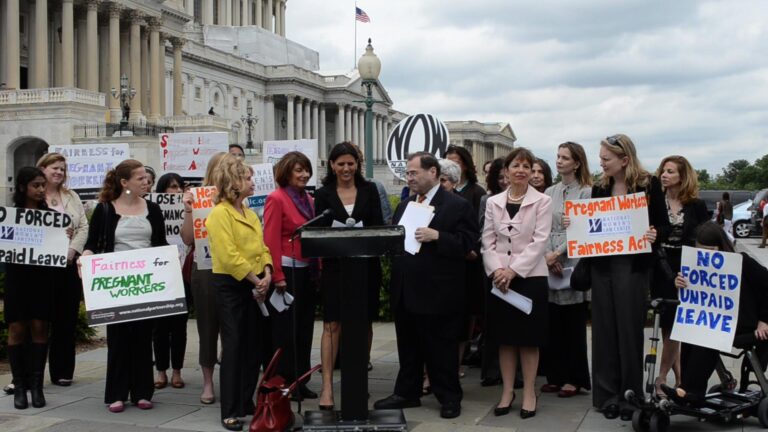
Mike Klain is a student at Harvard Law School and a member of the Labor and Employment Lab.
In July 2015, 26.7 million Americans tuned in to watch the U.S. Women’s National Soccer Team win the FIFA Women’s World Cup Final – at the time the most watched soccer game in American history. The U.S. Soccer Federation, the body that governs the U.S. Men’s and Women’s national soccer programs, awarded the team a total of $1.7 million in performance bonuses for winning the tournament. The prior summer, 16.5 million Americans had tuned in to watch the U.S. Men’s National Soccer Team fall to Belgium in the Round of 16 of the FIFA Men’s World Cup. Despite the early exit from the tournament, the U.S. Soccer Federation awarded the team $5.4 million in performance bonuses.
Now, the U.S. Women’s National Team is seeking to close the pay discrepancy between the Men’s and Women’s teams during its ongoing collective bargaining negotiations with the U.S. Soccer Federation. With the current CBA set to expire on December 31, the parties are quickly running out of time to reach an agreement. A key sticking point remaining in the negotiations is that FIFA, the governing body for international soccer, offers a larger prize pool to competitors in the Men’s World Cup than competitors in the Women’s World Cup. Still, the U.S. Soccer Federation has a few tools it can utilize to help successfully bridge the lingering divides. The stakes of these negotiations are incredibly high: the U.S. Women’s National Team is on the forefront of a global push for gender pay equity.
How the Parties Got Here: Anti-Discrimination Lawsuit
In March 2019, all 28 women in the U.S. National Team player pool filed a gender discrimination lawsuit against the U.S. Soccer Federation. The suit contained two claims: first, that pay disparities between the Men’s team and Women’s team violated the Equal Pay Act, and second, that disparities in working conditions (such as playing field surface conditions, charter flights, and other travel accommodations) violated Title VII of the Civil Rights Act.
Judge Gary Klausner of the United States District Court for the Central District of California granted the U.S. Soccer Federation’s motion to dismiss most of the lawsuit, holding that the evidence proffered by the plaintiffs did not establish a prima facie case of wage discrimination, in part because the Women’s National Team Players were paid more than the Men’s National Team Players on a cumulative and average per-game basis during the class period (though they were paid less than they would have been paid under the terms of the Men’s CBA). Judge Klausner did, however, allow the plaintiffs’ Title VII claim regarding discriminatory working conditions to proceed. After the U.S. Women’s National Team players reached a partial settlement on the working conditions claim that Judge Klausner had allowed to proceed, the Women’s National Team players appealed the dismissal of the remaining claims. The appeal process remains ongoing.
Where they Are Now: Ongoing Contract Negotiations
Meanwhile, the U.S. Women’s National Team Players Association and the U.S. Soccer Federation have begun negotiations for a new Collective Bargaining Agreement. On September 14th, the U.S. Soccer Federation released a statement that it had offered identical contract proposals to the Women’s and Men’s Players Associations. In the statement, the Federation expressed its desire for the Women’s and Men’s Associations to negotiate together for a single contract in order to ensure the final agreements are equitable.
The Women’s National Team Players Association responded to the Federation’s press release with a tweet that stated: “USSF’s PR stunts and bargaining through the media will not bring us any closer to a fair agreement. In contrast, we are committed to bargaining in good faith to achieve equal pay and the safest working conditions possible. The proposal that USSF made recently to us does neither.”
Although the Players Association has not released any further statements elaborating on their tweet, one reason disparate compensation may remain entrenched even if the Men’s and Women’s teams had identical CBAs with the U.S. Soccer Federation is that the FIFA prize pool for the Men’s World Cup is larger than the prize pool for the Women’s World Cup. For example, 32 teams competed in the 2018 Men’s World Cup for a pool of $400 million. Meanwhile, 24 teams competed in the 2019 Women’s World Cup for a pool of just $30 million. If the new CBA stipulates that – in addition to direct and equal bonuses from the U.S. Soccer Federation – the players receive a certain proportion of the prize money that they earn from FIFA, the CBA could contain equal terms but result in inevitably unequal outcomes.
Next Steps: Getting to an Agreement
The USSF appeared to acknowledge this possibility in its statement, asking the Men’s and Women’s National Team players to “join the Federation in finding a way to equalize FIFA World Cup prize money between the USMNT and the USWNT.” It also committed to “not agree to any collective bargaining agreement that does not take the important step of equalizing FIFA World Cup prize money.” The USWNTPA’s critical response indicates that these assurances alone are not sufficient, and that the Federation will have to find new strategies to bring parity to FIFA prize payouts quickly. FIFA itself has expressed an openness to renegotiate its investments in, and prize payouts from, future Women’s World Cups. There are several strategies the USSF can pursue to maximize its leverage in these negotiations to ensure the outcome is complete pay equity.
First, the Federation can threaten that the U.S. National Teams will boycott upcoming tournaments if prize payouts from FIFA are not equitable. The next major Men’s tournament is the 2022 World Cup in Qatar. Of course, this threat would only carry weight if the Men’s team qualifies for the tournament, which they failed to do in the previous cycle. The next major Women’s tournament is the 2023 World Cup in Australia and New Zealand. It’s possible this threat will carry less weight for FIFA given the tournament begins over a year after the current CBA lapses.
Another possibility would be for the Federation to partner with other countries to jointly threaten a boycott. The Players Association in Australia, for example, another country with a highly competitive Women’s National Team, has announced its intention to push for pay equity in FIFA prize money. Recently, both Brazil and England announced their intention to equalize pay for their Women’s and Men’s soccer teams, indicating they might be open to a broader push for international reform. If the U.S. Soccer Federation can secure commitments from enough global soccer federations that they will jointly mount a campaign for pay equity from FIFA before the CBA expires, it could give the U.S. Women’s National Team enough comfort to move forward.
Finally, the Federation could engage with other relevant American stakeholders to increase their leverage with FIFA. For example, the U.S. Soccer Federation could work with FOX, which owns the broadcasting rights for the World Cup, to secure their commitment to boycott the World Cup if the prize pools are not equal. While the USSF is running out of time to demonstrate the seriousness of its efforts to secure equal FIFA prize money before the current Collective Bargaining Agreement expires on December 31st, there are several immediate steps it could take to regain the trust of the Women’s Players, and put the negotiations back on a path to success.








Daily News & Commentary
Start your day with our roundup of the latest labor developments. See all
June 30
Antidiscrimination scholars question McDonnell Douglas, George Washington University Hospital bargained in bad faith, and NY regulators defend LPA dispensary law.
June 29
In today’s news and commentary, Trump v. CASA restricts nationwide injunctions, a preliminary injunction continues to stop DOL from shutting down Job Corps, and the minimum wage is set to rise in multiple cities and states. On Friday, the Supreme Court held in Trump v. CASA that universal injunctions “likely exceed the equitable authority that […]
June 27
Labor's role in Zohran Mamdani's victory; DHS funding amendment aims to expand guest worker programs; COSELL submission deadline rapidly approaching
June 26
A district judge issues a preliminary injunction blocking agencies from implementing Trump’s executive order eliminating collective bargaining for federal workers; workers organize for the reinstatement of two doctors who were put on administrative leave after union activity; and Lamont vetoes unemployment benefits for striking workers.
June 25
Some circuits show less deference to NLRB; 3d Cir. affirms return to broader concerted activity definition; changes to federal workforce excluded from One Big Beautiful Bill.
June 24
In today’s news and commentary, the DOL proposes new wage and hour rules, Ford warns of EV battery manufacturing trouble, and California reaches an agreement to delay an in-person work mandate for state employees. The Trump Administration’s Department of Labor has advanced a series of proposals to update federal wage and hour rules. First, the […]